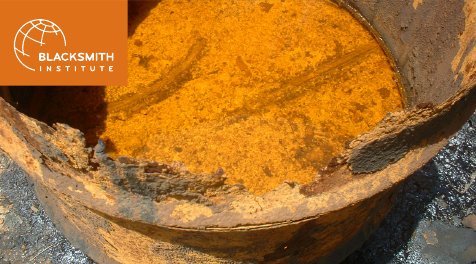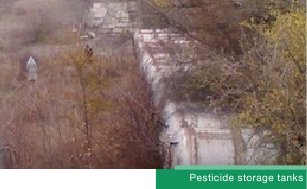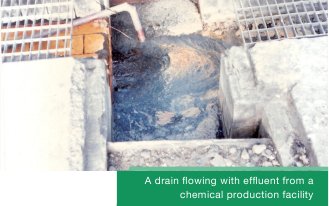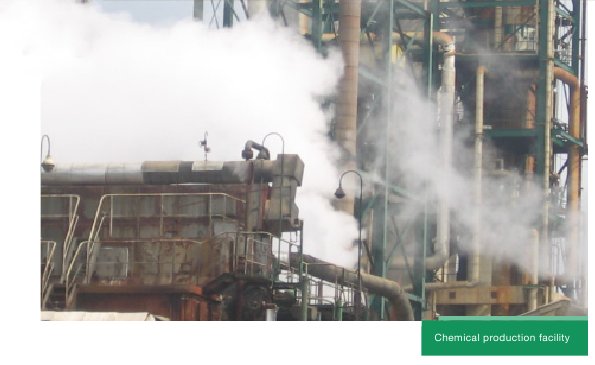Pesticides
Estimated Population At Risk At Identified Sites:
3.4 Million People
Estimated Global Impact:
5 to 8 Million People
Introduction
Pesticides are those substances, often chemical in nature, that are used with the intent to repel or eliminate species that have an adverse affect on agricultural or horticultural production. Pesticides are also used to fight tropical diseases like malaria. This class of pollutants falls under the umbrella of agrochemicals or agrotoxins—which can also include fertilizers—and was initially developed to improve agricultural output, enhance crop growth, and repel or eliminate pests that hinder high yields. Pesticides began to be used on a large scale as early as the 15th century, when chemicals such as arsenic and lead were added to soil to eliminate insect species. The push toward further use of chemicals came between the 17th to 19th centuries, when a range of compounds—including nicotine sulfate, pyrethrum, and rotenone, to name a few—were extracted from natural products for their efficiency in allowing plant yields to increase without being hindered by various parasites. [66]
The term pesticide encompasses a variety of compounds that are used for different purposes in agriculture. A “pesticide” can be classified as an insecticide, herbicide, fungicide, nematocide, or molluscicide. Pesticides work by interfering with essential biological mechanisms of their target species, primarily through actions such as paralyzing an insect’s nervous system. However, since these mechanisms are not specific to one species, these chemicals potentially harm other organisms, including humans..
Examples of especially harmful pesticides include the organophosphate and organochlorine classes of pesticides. Organophosphates affect an organism’s nervous system by disrupting the enzymes that regulate specific neurotransmitters, and most of the pesticides within this group are insecticides. Certain organophosphates were also produced during World War II for the potential use as chemical warfare agents. [67] Examples of organophosphates include chlorpyrifos, methyl parathion, azinphos methyl, and malathion. Likewise, the category of organochlorine pesticides includes chemicals so harmful—such as DDT, chlordane, and lindane—that their use is banned in many countries. Other pesticides with serious health impacts include glyphosate, methyl bromide, metadof, duron, and novaquat. Many of these above compounds are listed as Highly Hazardous or Restricted Use Pesticides.
Common Exposure Pathways and Health Effects
 A significant percentage of the millions of tons of pesticides used each year is washed away by rainfall into nearby surface and ground water. Additionally, because many commonly used pesticides are classified as Persistent Organic Pollutants (POPs)—chemicals that have long life spans and can bioaccumulate in human and animal tissue—a range of non-pest organisms absorb these pesticides. Some sources have concluded that over 98% of sprayed insecticides and 95% of herbicides contaminate sources other than the intended target organisms, such as the air, water, bottom sediments, and food sources. [68]
A significant percentage of the millions of tons of pesticides used each year is washed away by rainfall into nearby surface and ground water. Additionally, because many commonly used pesticides are classified as Persistent Organic Pollutants (POPs)—chemicals that have long life spans and can bioaccumulate in human and animal tissue—a range of non-pest organisms absorb these pesticides. Some sources have concluded that over 98% of sprayed insecticides and 95% of herbicides contaminate sources other than the intended target organisms, such as the air, water, bottom sediments, and food sources. [68]
Pesticides enter and pollute the environment primarily through their direct application in agricultural fields, since large volumes of these chemicals are used in excess and indiscriminately to large swaths of land. The leaching of chemicals at pesticide storage facilities is another major exposure pathway. The primary pathway of human exposure, however, is direct dermal contact and absorption of chemicals. Surveys of general knowledge of pesticide application in many low- and middle-income countries indicate that pesticides are typically used without protective equipment. [69] Often, farmers and workers in these countries lack both access to and finances for basic protective gear and equipment. A survey of over 2000 workers in Asia, Africa, and Latin America found that between 47% and 59% of workers reported suffering from headaches and dizziness after the application of pesticides. The majority of these workers also reported not using protective gear. [70]
These chemicals also enter the human body through inhalation when one breathes in dust or chemical spray. Outside of these occupational forms of exposure, people are also impacted through drinking ground water that has been polluted from runoff from fields or leachate from production and storage facilities. Another significant pathway exists through contact with and ingestion of food items sprayed or contaminated with pesticides. Between 1993 and 1994, around 600 cases of food poisoning were reported in Vietnam that stemmed from eating contaminated produce. [71] Related studies in Vietnam have also indicated that people can be exposed to organochlorines—even now illegal ones such as DDT—through the consumption of seafood in which the compounds have bioaccumulated. [72] The World Health Organization, in conjunction with the United Nations Environment Programme, has found that each year 3 million agricultural workers suffer from acute cases of pesticide poisoning, many of which occur in low- and middle-income countries. An additional 20,000 unintentional deaths and 735,000 cases of chronic illness occur as impacts of these chemicals. [73] However, the health impacts of pesticides cannot be generalized, as each depends on the specific substance or chemical used in the product.
Acute effects of pesticide exposure can include headaches, nausea, dizziness, and convulsions, all of which were documented health impacts in a survey of over 2,000 agricultural workers in Africa, Asia, and Latin America. [74] Additionally, the extent of acute pesticide poisoning in many agricultural workers in these countries is often underreported and based on inadequate information. [75] Certain insecticides, such as the organochlorine lindane, are highly persistent in the environment and are clearly capable of affecting the human nervous system. [76] Lindane has been linked to breast and other cancers, as well as fertility problems. It is associated with skin irritation and nausea, and can even cause convulsions and death at high levels of acute exposure.
The economic costs of these acute effects can be significant. A recent study in Nepal found that the average cost of illness resulting from pesticide exposure was 114 Nepalese Rupees per person, nearly one-third of one’s total expenditure on health services. Healthcare costs for people suffering from pesticide-related illness were nearly eight times higher than for those not directly exposed to pesticides. [77] Additionally, the results of a study of farmers in Vietnam indicated a high prevalence of poisoning by organophosphates and carbamates, where a high percentage of subjects were not only acutely, but also chronically, poisoned. [78]
Studies on chronic health effects of pesticide exposure indicate the potential for these chemicals to have neurological, reproductive, and dermatological impacts. [79] Chronic head and stomach aches, loss of vision, birth defects, damage to the central nervous system, immune system deficiencies, pulmonary diseases, respiratory difficulties, deformities, DNA damage, disruption of the hormonal system, and death are all possible outcomes of pesticide exposure. Exposure to pesticides has also been proven to be an important risk factor in the development of cancer. The use of insecticides has been associated with cancers of the prostate, pancreas, liver, and other organs. [80] More recently, studies of contact with organophosphates have shown that exposure to the residues of these compounds on fruits and vegetables may double a child’s risk of attention deficit hyperactivity disorder. [81]

Industrial Sources of Pesticides – Agricultural Application
Industry Overview
Agriculture is often one of the most important sectors in the economies of low- and middle-income countries. Studies indicate that GDP growth from agriculture benefits the income of these countries’ populations by two to four times that of GDP growth in other economic activities. [82] In terms of enhancing this sector, agrochemicals were initially developed to improve agricultural output, enhance crop growth, and repel or eliminate pests that hindered high yields. Of the latter, chemical pesticides were often too effective, harming other organisms besides the intended pests and polluting the environment through various pathways. Today, the practice of intense pesticide and fertilizer application is recognized as harmful to both ecological and human health. The overuse of agricultural fertilizers, which are also included under the category of agrotoxins, can release urea, nitrogen, phosphates, and heavy metals, which can also have harmful ecological and health impacts.
Global Context
The extensive use of agrochemicals in low- and middle-income countries has created a tension between the need to ensure local food security and the desire to protect the public from the adverse effects of these compounds. [83] Many of these countries are in transitional phases where agricultural workers are migrating to urban centers to secure a higher income, which leaves fewer people responsible for food production. Many of these same countries have become food exporters for higher-income regions. These combined pressures have led to an increased reliance on chemical pesticide use, especially in rural regions. [84]
Such was the case during the Green Revolution, a series of internationally-sponsored developments and technology initiatives between the late 1940s and 1970s that sought to increase agricultural production, primarily in India. These programs centered on not only expanding industrial irrigation infrastructure and developing new hybrid seed varieties, but also heavily increasing the use of agrochemicals, primarily synthetic fertilizers and potentially harmful pesticides. The primary criticisms of these initiatives rested upon the increasing disparity between rural and industrial farmers due to the latter’s access to credit and land, which in turn furthered dependence on the use of pesticides to increase yields, especially in rural areas.
 In general, the application of agrochemicals has significantly increased since their advent in the 1940s. Roughly 2.3 million tons of industrial pesticides are now used per year, 50 times the amount used in 1950. Current statistics indicate that over $40 billion was spent globally on pesticide use in 2008. [85] Following the dangerous nature of many of these pesticides used in low-income countries, surveys done by the Pesticide Action Network in Asia found that seven out of ten of the most commonly used pesticides are classified as Highly Hazardous. In most of these regions, it was also found that safe storage for these chemicals was lacking, few facilities existed to recycle empty containers, local awareness of hazards was low, and proper training was often unavailable.
In general, the application of agrochemicals has significantly increased since their advent in the 1940s. Roughly 2.3 million tons of industrial pesticides are now used per year, 50 times the amount used in 1950. Current statistics indicate that over $40 billion was spent globally on pesticide use in 2008. [85] Following the dangerous nature of many of these pesticides used in low-income countries, surveys done by the Pesticide Action Network in Asia found that seven out of ten of the most commonly used pesticides are classified as Highly Hazardous. In most of these regions, it was also found that safe storage for these chemicals was lacking, few facilities existed to recycle empty containers, local awareness of hazards was low, and proper training was often unavailable.
Because of the recognition of the extent to which many agrochemicals adversely impact human health, many pesticides, particularly organophosphates and organochlorides, are banned in high-income countries. In 1985, the International Code of Conduct on the Distribution and Use of Pesticides was adopted. It was then amended in 1989, and further revised in 2002. This piece of legislation set standards to guide national laws. However, because many of these formerly restricted and banned pesticides are highly effective and cheap to produce, many are still actively used throughout low- and middle-income countries. [86] This often results in the creation of black markets beyond the control of governments.
The majority of the world’s rural poor are engaged in agriculture. [87] In many of these areas, regulation and local awareness of pesticide health hazards is low, and therefore many older, highly toxic, and inexpensive pesticides are applied extensively. [88] Due to this context, farmers in these nations are heavily burdened by pesticide use, and this burden particularly falls on women, children, and infants. [89] While these countries use only 20% of the world’s agriculture, their populations suffer 99% of global deaths from pesticide poisoning. [90]
Exposure Pathways from Agricultural Application
 Pesticides used in agriculture often migrate to nearby streams, rivers, lakes, and ground water sources through rainfall runoff. Many of these then go on to accumulate in the tissue of aquatic organisms. In some cases, almost 100% of sprayed insecticides and herbicides end up contaminating the environment beyond impacting their intended agricultural pest targets. [91]
Pesticides used in agriculture often migrate to nearby streams, rivers, lakes, and ground water sources through rainfall runoff. Many of these then go on to accumulate in the tissue of aquatic organisms. In some cases, almost 100% of sprayed insecticides and herbicides end up contaminating the environment beyond impacting their intended agricultural pest targets. [91]
Those engaged in agriculture are exposed to pesticides through dermal exposure. In the majority of low- and middle-income countries, pesticides are typically applied without the use of protective equipment, more often than not due to a lack of access to and finances for such gear. [92] The active chemicals in pesticides also enter the human body through inhalation when one breathes in chemical sprays during pesticide application in fields. People are also impacted through drinking ground water and consuming produce that has been polluted.
What is Being Done
International efforts to eradicate toxic pesticides include the Stockholm Convention on Persistent Organic Pollutants, an agreement developed by the United Nations Environment Programme. The Convention seeks to reduce or eliminate the production of the most toxic pesticides and other persistent organic pollutants. [93] The Food and Agriculture Organization of the United Nations (FAO) also tries to introduce globally modern agricultural practices with the aims to minimize the future use of pesticides, respond more effectively to pest outbreaks, and reduce the creation of new stocks.
Apart from international legislation, community-based education programs for farmers have a significant role in reducing the use of hazardous pesticides. Governments, often with international support, typically run such programs, but in some cases pesticide producers concerned with safe and responsible usage of their product offer them to retailers. In some cases, local NGOs provide education, such as “Plagbol” (Plaguicidas Bolivianas), a Bolivian organization that offers telephone advice and training programs for the appropriate use of pesticides. [94]
Blacksmith Institute has supported programs to develop “best practices” for pesticide application and to identify local reduction strategies. In Cambodia, farmers and their families living around the Tonle Sap Lake are being harmed from the contamination of food and water supplies due to inappropriate pesticide use. As safety measures are often ignored or misunderstood, Blacksmith Institute is currently raising funds and working to provide local training in appropriate pesticide application and storage. A plan to raise awareness about alternatives to chemical pesticides is being developed with local partners. Green Cross Switzerland works closely with the UN and other organizations to build capacity within countries of the Former Soviet Union on the inventory, repacking, safe storage, and final elimination of their substantial stocks of obsolete pesticides.
Industrial Sources of Pesticides – Production and Storage
Industry Overview

Despite international conventions, a number of Highly Hazardous or Restricted Use Pesticides continue to be produced, stored, and used. Some categories of pesticides that continue to be stored include persistent organic pollutants, organochlorines, organophosphates, and carbamates. Specific pesticides include heptachlor, chlordane, DDT, dieldrin, aldrin, endosulfan, and profenofos.
Often, the facilities where large amounts of now-banned pesticides are stored are themselves very old, and have fragile infrastructures and limited maintenance: drums of toxic chemicals are stored in the open, and containers deteriorate and leak over time. In these regions, storehouses are commonly regarded as hazardous waste sites. Because of temporal gaps between when production and storage facilities were constructed and when they were closed, many of the areas where these buildings were built became urban centers, surrounded by residential zones, offices, and markets. [95]
Global Context
The majority of stocks of old, hazardous pesticides can be found in low- and middle-income countries. While many pesticide production facilities were originally constructed following the Green Revolution to meet agriculture demands, they now too remain abandoned. Farmers in these areas purchase harmful pesticides because they are cheap, and because the perceived risk of not using them is too high. As of 1996, the Food and Agriculture Organization of the United Nations estimated that the total number of obsolete pesticide stocks in African countries amounted to 15,000 to 20,000 tons. [96] Current figures for the Former Soviet Union point to obsolete stocks of at least 350,000 tons. Blacksmith Institute’s site assessment efforts have shown that many of these abandoned storage and production facilities are located in Russia, Central Asia, India, Pakistan, and Nepal. In many of these areas, the key pesticide pollutant is DDT.
Exposure Pathways from Pesticide Production and Storage
Leaks from pesticide storage facilities pose a threat human health through contaminated water and soil. Soil can remain contaminated long after an initial exposure, and because many storage facilities are located near homes, dermal contact and inhalation of dust are likely pathways.
DDT is an organochloride pesticide that is commonly found in many of these storage sites, is highly persistent in the environment, and does not easily degrade by biological, physical, or chemical processes. Furthermore, DDT can travel long distances and accumulate in human bodies due to its solubility in fats. Even in small amounts, DDT can injure human health and health of other organisms. It is harmful to the stomach, intestines, liver, and kidneys, and can affect the nervous system. DDT can cause reproductive, developmental defects and cancer and tumors, and can potentially cause learning disabilities in children.
What is Being Done
International efforts to reduce pesticide stockpiles are making measurable differences. The Africa Stockpiles Programme is an example of one multilateral effort to clean up such sites and prevent their recurrence. This program currently operates in Ethiopia, Mali, Morocco, Nigeria, South Africa, Tanzania, and Tunisia.
Footnotes
[66] G.T. Miller. “Living in the Environment” (12th Ed.). Belmont: Wadsworth/Thomson Learning, 2002.
[67] U.S. Environmental Protection Agency. “About Pesticides.” Available at http://www.epa.gov/pesticides/about/types.htm, September 30, 2010.
[68] G.T. Miller.“Chapter 9.” Sustaining the Earth. 6th ed. Pacific Grove, California: Thompson Learning, Inc., (2004): 211–216.
[69] C. Wesseling, et al. “Agricultural Pesticide Use in Developing Countries: Health Effects and Research Needs.” International Jornal of Health Services 27.2 (1997): 273–308.
[70] Pesticide Action Network International. “Communities in Peril: Global Report on Health Impacts of Pesticide Use in Agriculture.” Available at http://www.pan-international.org/panint/files/PAN-Global-Report.pdf, 2010.
[71] H.D. Nguyen, et al. “Impact of Agro-Chemical Use on Productivity and Health.” International Development and Research Center. Available at http://www.idrc.ca/es/ev-8428-201-1-DO_TOPIC.html, 2003.
[72] D.D. Nhan, et al. “Organochlorine pesticides and PCBs Along the Coast of North Vietnam.” The Science of the Total Environment 237-238 (1999): 363–371.
[73] WHO and UNEP. “Public Health Impacts of Pesticides used in Agriculture”. Geneva, Switzerland, 1990.
[74] Pesticide Action Network International. “Communities in Peril: Global Report on Health Impacts of Pesticide Use in Agriculture.” Available at http://www.pan-international.org/panint/files/PAN-Global-Report.pdf, September 22, 2010.
[75] M.H. Litchfield. “Estimates of Acute Pesticide Poisoning in Agricultural Workers in Less Developed Countries.” Toxicological Reviews 24.4 (2005): 271–278.
[76] Agency for Toxic Substances and Disease Registry, U.S. Department of Health and Human Services. “Toxicologic Profile for Alpha-, Beta, Gamma- and Delta-Hexachlorocyclohenxane.” Available at http://www.atsdr.cdc.gov/toxprofiles/tp43.pdf, August 2005.
[77] K. Atreya. “Health Costs from Short-Term Exposure to Pesticides in Nepal.” Social Science & Medicine 67.4 (2008): 511–519.
[78] S. Dasgupta, et al. “Pesticide Poisoning of Farm Workers – Implications of Blood Test Results from Vietnam.” International Journal of Hygiene and Environmental Health 210.2 (2007): 121–132.
[79] C. Wesseling, et al. “Agricultural Pesticide Use in Developing Countries: Health Effects and Research Needs.” International Jornal of Health Services 27.2 (1997): 273–308.
[80] K. Jaga and C. Dharmani. “The Epidemiology of Pesticide Exposure and Cancer: A Review”. Reviews on Environmental Health 20.1 (2005): 15–38.
[81] M.F. Bouchard, et al. “Attention-Deficit/Hyperactivity Disorder and Urinary Metabolites of Organophosphate Pesticides.” Pediatrics, 2010.
[82] K. Aseno-Okyere, et al. “Advancing Agriculture in Developing Countries through Knowledge and Innovation.” International Food Policy Institute, 2008.
[83] C.N. Kesavachandran. “Adverse Health Effects of Pesticides in Agrarian Populations of Developing Countries.” Reviews of Environmental Contamination and Toxicology 200 (2009): 33–52.
[84] C. Ponting. “A New Green History of the World: The Environment and the Collapse of Great Civilizations”. Penguin Books, New York, 2007.
[85] Pesticide Action Network International. “Communities in Peril: Global Report on Health Impacts of Pesticide Use in Agriculture.”Pesticide Action Network International. Available at http://www.pan-international.org/panint/files/PAN-Global-Report.pdf, September 22, 2010.
[86] C. Wesseling, et al. “Agricultural Pesticide Use in Developing Countries: Health Effects and Research Needs.” International Journal of Health Services 27.2 (1997): 273–308.
[87] K. Aseno-Okyere, et al. “Advancing Agriculture in Developing Countries through Knowledge and Innovation.” International Food Policy Institute, 2008.
[88] D.J. Ecobichon. “Pesticide Use in Developing Countries.” Toxicology 160.1-3 (2001): 27–33.
[89] L.R. Goldman. “Childhood Pesticide Poisoning: Information for Advocacy and Action.” World Health Organization, Geneva, Switzerland, 2004. Available at http://www.who.it/ceh/publications/pestpoisoning.pdf, September 22, 2010.
[90] J. Jeyaratnam and K.S. Chia. “Occupational Health in National Development.” Singapore: World Scientific, 1994.
[91] G.T. Miller. “Chapter 9.” Sustaining the Earth. 6th ed. Pacific Grove, California: Thompson Learning, Inc. (2004): 211–216.
[92] C. Wesseling, et al. “Agricultural Pesticide Use in Developing Countries: Health Effects and Research Needs.” International Jornal of Health Services 27.2 (1997): 273–308.
[93] Stockholm Convention on Persistent Organic Pollutants. “Measures to Reduce or Eliminate POPs.” Available at http://chm.pops.int/, 2009.
[94] Jors, Erik. “Acute Pesticide Poisonings Among Small-Scale Farmers in La Paz County Bolivia.” Department of International Health Institute of Public Health, University of Copenhagen, 2004.
[95] Food and Agriculture Organization of the United Nations. “Prevention and Disposal of Obsolete Pesticides.” Available at http://www.fao.org/ag/AGP/AGPP/Pesticid/Disposal/en/103115/103122/index.html, 2009.
[96] A. Wodagene and H. van der Wulp. “Obsolete Pesticides in Developing Nations.” Pesticides News 32 (1996): 12–13.




